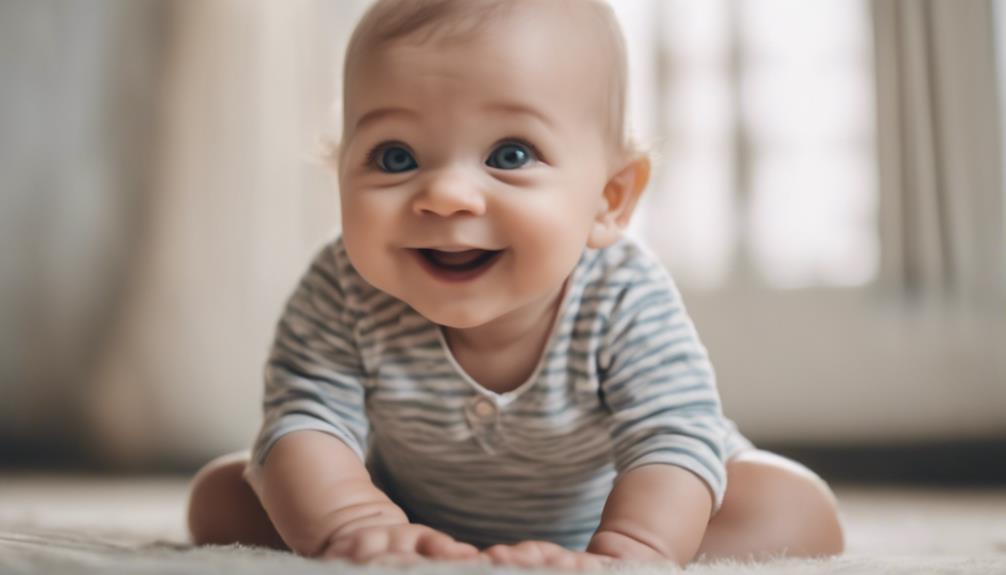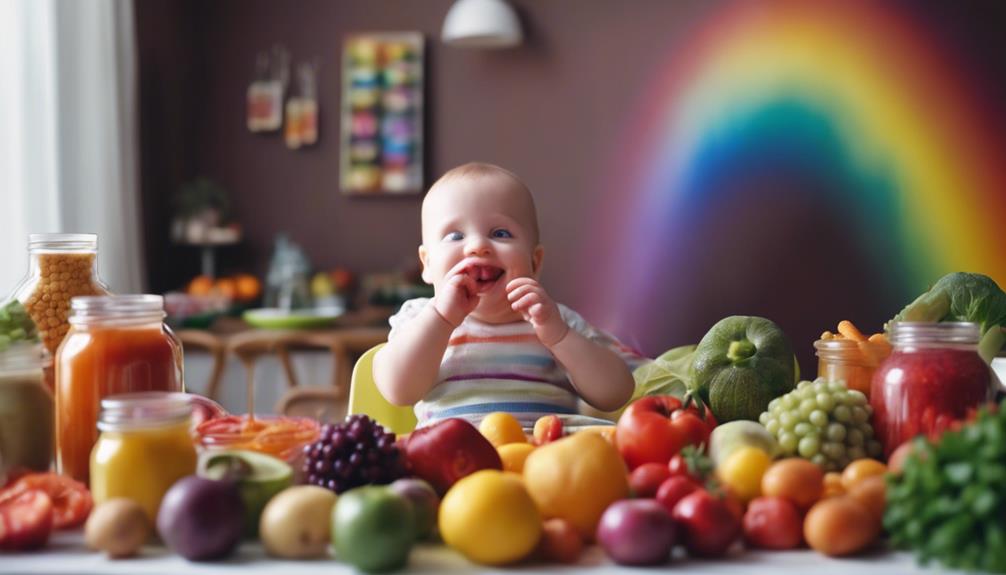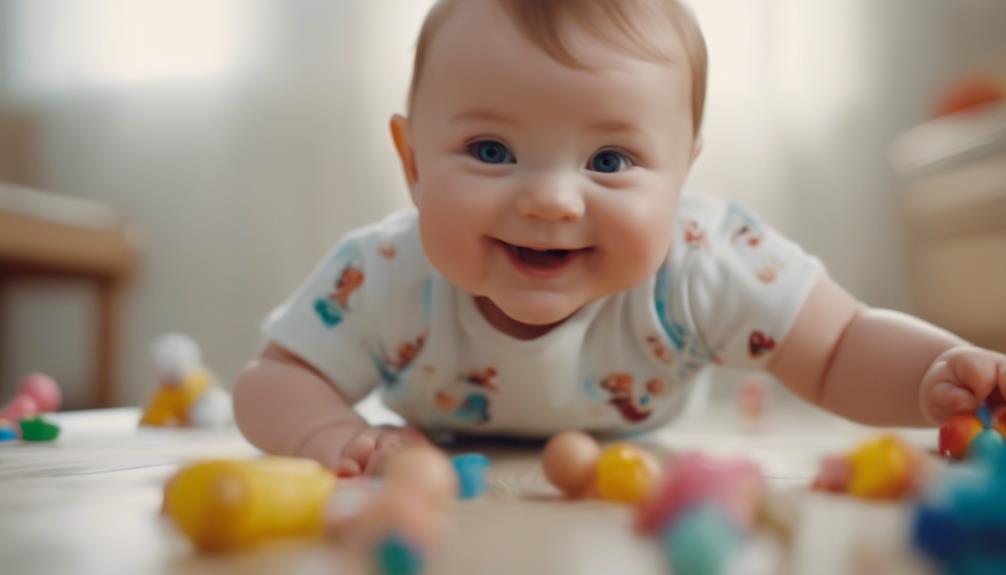To determine if your baby is happy, look for a relaxed face with a gentle smile and bright eyes. Pay attention to cooing, babbling, and cheerful sounds. Observe active engagement such as reaching or gestures. Notice calmness and comfort in their behavior. Watch for peaceful movements, a drowsy look, and positive reactions. Take note of smiles, eye contact, and emotional connections. Listen for happy vocalizations and laughter. Keep an eye out for contented sighs or hums. Look for joyful sounds and happy sleep patterns. By observing these cues, you will gain a better understanding of your baby’s happiness.
Key Takeaways
- Relaxed facial expressions and gentle smiles
- Active engagement like reaching for objects
- Cooing, babbling, and cheerful vocalizations
- Bright eyes and alertness
- Peaceful sleep patterns and contented waking
Facial Expressions and Reactions
Look for a relaxed face with a gentle smile or content expression to determine if your baby is happy. Babies often express positive emotions through their facial expressions.
Notice bright eyes and alertness, signaling their engagement with the world around them. Pay attention to cooing, babbling, and cheerful vocalizations as these are indicators of their happiness.
When your baby is happy, you may also observe active engagement, such as reaching out for objects or making playful gestures. A settled demeanor, where your baby appears calm and comfortable, is another sign of their contentment.
Body Language and Movements

Notice how your baby's body language and movements can provide valuable insights into their emotional well-being and happiness. Happy babies often exhibit relaxed movements and contented facial expressions. A peaceful or drowsy appearance may indicate that your baby is feeling content and secure.
Additionally, smiling, cooing, and babbling are common signs of a happy baby. Keep an eye out for positive reactions to familiar faces and voices, as this can further confirm your baby's happiness. When your baby is happy, you may notice a lack of distress signals like crying or fussiness.
Observing these cues in your baby's body language can help you gauge their emotional state and make sure that they're feeling joyful and comfortable in their environment. By paying attention to these subtle indicators, you can better understand and respond to your baby's needs, fostering a strong bond and promoting a sense of security and happiness.
Eye Contact and Smiling
Pay attention to how your baby engages with you through eye contact and smiling to understand their happiness levels and emotional connection. Babies communicate their joy through these gestures, forming a crucial bond with their caregivers.
Here are three key points to ponder regarding your baby's eye contact and smiling:
- Early Signs of Happiness: Smiling can be one of the earliest indicators of your baby's happiness, often appearing around 4-10 weeks of age. This genuine display of joy signifies their contentment and comfort in your presence.
- Emotional Connection: Eye contact plays an essential role in building emotional bonds between the baby and caregivers. When your baby looks into your eyes, it shows a sense of trust, security, and connection, enhancing the overall relationship.
- Monitoring Happiness Levels: By observing your baby's eye contact and smiling patterns, you can gain insights into their happiness levels. Increased eye contact and frequent smiles indicate a positive emotional state, allowing caregivers to respond and nurture their baby's well-being effectively.
Sound and Vocalizations

To understand your baby's happiness, listen closely to their sounds and vocalizations, as they offer valuable insights into their emotional state. Even very young babies have the capacity to express positive responses to something through their vocalizations. Happy sounds like cooing, babbling, and giggling are good signs that your baby is content.
Laughter is a clear indicator of a happy baby, while contented sounds such as sighs or hums also suggest their well-being. Pay attention to sounds of excitement, like squeals or high-pitched noises, as they show happiness. Your baby might also be aware of their surroundings and express joy through their vocalizations.
When your baby looks at you and makes these happy sounds, it's a reassuring sign that they're in a positive emotional state. So, tune in to the tone and pitch of your baby's vocalizations to better understand their happiness.
Sleep Patterns and Contentment
When it comes to understanding your baby's happiness, observing their sleep patterns and contentment can provide valuable insights into their emotional well-being. A happy baby typically displays longer periods of peaceful sleep and wakes up content, indicating a sense of security and comfort.
Contentment during sleep can be observed through relaxed body movements and serene facial expressions, showcasing a state of relaxation and well-being. Consistent sleep patterns with minimal disturbances are signs of a happy and well-rested baby, contributing to their overall contentment and joy.
Additionally, babies may exhibit signs of happiness during sleep, such as smiling or cooing, reflecting their comfort and satisfaction. Monitoring your baby's sleep cues and patterns can help you gauge their level of contentment and overall happiness, ensuring they're well-rested and emotionally fulfilled.
Frequently Asked Questions
What Are the Signs of a Happy Baby?
You can tell if your baby is happy by observing calmness, first smiles, positive reactions to you, minimal crying, peaceful sleep, and engagement in play. These signs show contentment and joy in your little one.
What Is One of the Best Signs of Good Health in a Baby?
One of the best signs of good health in your baby is consistent weight gain and regular wet diapers. These indicators suggest your little one is thriving and developing well, giving you peace of mind.
How to Identify a High IQ Baby?
To identify a high IQ baby, observe early signs like advanced problem-solving skills, exceptional memory retention, and fast language development. Look for heightened curiosity, enthusiasm to explore, and strong focus on tasks.
How Can You Tell if a Baby Is Thriving?
To know if a baby is thriving, watch for signs of contentment in their body movements. Look for eye contact and positive responses to faces and voices. Laughter and smiles are key indicators. Meeting basic needs is essential.
Conclusion
Just like a skilled artist who can read the emotions of their subject through the strokes of a brush, as a parent, you have the ability to decipher your baby's happiness through subtle cues and signals.
By paying attention to their facial expressions, body language, eye contact, sounds, and sleep patterns, you can gain valuable insights into their emotional well-being.
Trust your instincts and nurture the bond between you and your little one to foster a happy and healthy relationship.










